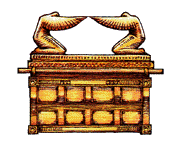The Ark on Mount Nebo?
The apocryphal book of 2 Maccabees has the following account:
". . . the prophet [Jeremiah], being warned of God, commanded the tabernacle and the ark to go with him, as he went forth into the mountain, where Moses climbed up [Mount Nebo], and saw the heritage of God. And when Jeremy came thither, he found an hollow cave, wherein he laid the tabernacle, and the ark, and the altar of incense, and so stopped the door. And some of those that followed him came to mark the way, but they could not find it. Which when Jeremy perceived, he blamed them, saying, As for that place, it shall be unknown until the time that God gather His people again together, and receive them unto mercy" (2:4-7).
This book was written well after the time of Jeremiah. The flaw in what it says is that one would have thought that the return from captivity, and the rebuilding of the temple, would have been the time for God to have revealed where the ark was so that it could be put into the newly built temple. However, the Scriptures are silent on this.
In 1981 an American called
Tom Crotser went to look for the ark in the area of Mount
Nebo. He claimed to have found a tunnel on Mount Pisgah
leading to a rock-hewn crypt in which was the ark along
with its carrying poles. He managed to get his
'discovery' internationally syndicated as a news report,
and claimed to have photographs which supported his
story. However, one archaeologist who looked at these
found only one to be at all clear, and that depicted a
yellow box, which appeared to be made of brass, and which
had a very modern-looking nail protruding from one
corner. There are, of course, a number of charlatans around
claiming sensational discoveries, and any story of the discovery
of a Bible artefact needs to be treated with considerable
caution.
Next section: Other theories

